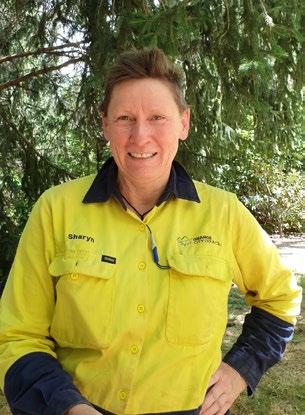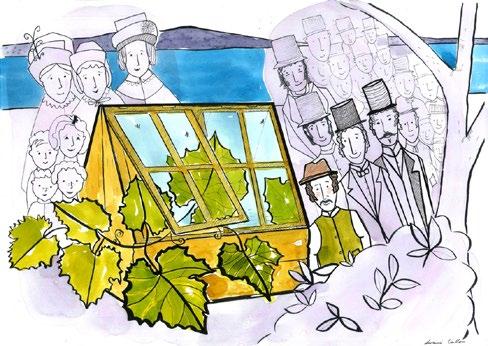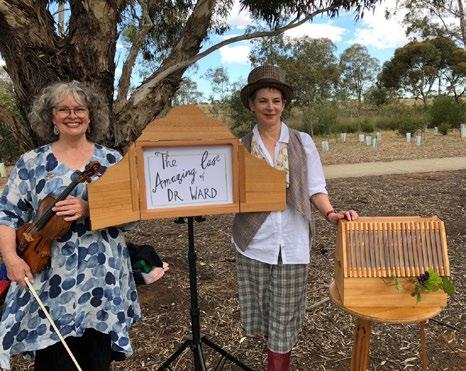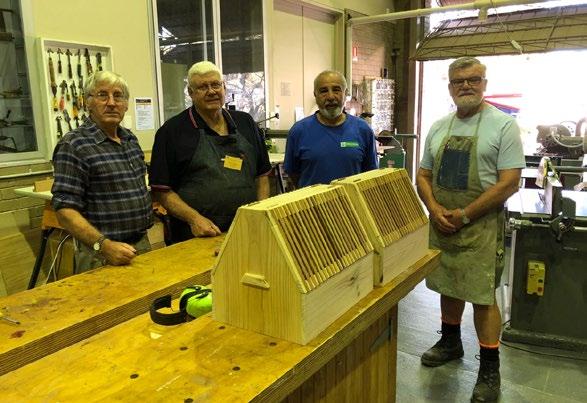
13 minute read
Plants for a passion, in pursuit of a dream
Sharyn Veivers, Horticulture Assistant, Orange Botanical Gardens
We’ve all had moments where we’ve said ‘it seemed like a great idea at the time, but...’ For some it does work out – and for Sharyn Veivers it did! Now a horticulturist working at Orange Botanical Gardens in New South Wales, Sharyn could be described as something of a late bloomer. She reflects on the journey that led her to study horticulture in her 50s and found her on something of a personal pilgrimage to the 9th BGANZ Congress in Wellington.
Sharyn Veivers
At an early age I spent a lot of time with my grandmothers, this was the 1960s and 70s. Not a mobile phone or internet in sight. We would spend all of our time in the garden. Both grandparents were passionate gardeners, so the seed of my future passion was planted.
I was taught how to grow plants from seed, the types of plants that grow from cuttings, aerial layering, marcotting etc., when to water and when not to, and how to create my own mulch. I couldn’t get enough of this plant stuff, watching things grow, and how birds, bees and other creatures worked together doing their natural thing.
I am also related to Walter Hill, Kew propagation manager in the 1800s and founder of Brisbane Botanic Gardens, situated at Gardens Point on the Brisbane River.
I grew up on 10 acres between Brisbane and the Gold Coast. My parents were also keen gardeners. Dad was a butcher. Chatting with a customer one day, he discovered he had a licence to import certain species from Asia and had a small nursery nearby. So, after allocating five acres of our property to a new project, we bought some tropical trees.
Some of the trees we planted were Black sapote, Diospyros digyna, Purple Mangosteen, Garcinia mangostana, Carambola, Averrhoa carambola and Custard Apple, Annona atemoya. We also had the usual banana trees and avocados – and mangos, 17 of them.
Life went on and I left home to live in Brisbane for work. My garden was my refuge, all 842 square metres of it. I joined a local Landcare for Wildlife group and another group that propagated natives for revegetation around Brisbane. As the years progressed and I became a little hard to live with, my partner and I sat down to discuss what I might like to do and how to get to that goal.
So, at 53 years old I started applying for horticulture traineeships and jobs, greenkeeper traineeships and jobs, anything where I could get a foot in the door. For two years I did this with no luck, always finding myself up against an overwhelming field of candidates; I even applied for roles as far afield as New Zealand. The constant in the ads for horticulture roles was ‘must have a Certificate II or III’.
So, at 53 years old I started applying for horticulture traineeships and jobs, greenkeeper traineeships and jobs, for two years I did this with no luck.
Getting a foot in the door
I eventually received a call for an interview for a Conservation and Land Management Certificate I traineeship. It was a start, six months and at a very reduced pay to what I was used to. Was I happy, though? Hell yes! It was so much easier to get out of bed in the mornings. The six months went by quickly and I had a Certificate I in CALM and felt confident. I was nominated for student of the year, missed out on that title but was still excited about the nomination. Within a week of completing the certificate, I was employed with an environmental revegetation company.
The revegetation role was very much about weed eradication and it was casual. I wanted to learn more about horticulture and botany, the science, the history, and the wonderful beauty when working in an open space ‘office’, which is always changing.
With family connections in regional New South Wales, I was alerted to an opportunity for a 12-month horticulture Certificate II traineeship at the local botanical gardens. I applied, was called for a phone interview, which progressed to a face-to-face interview, and a couple of weeks later, I was offered the traineeship.
The traineeship was extended from a Certificate II to a Certificate III and with the support of my partner, who was still working back in Brisbane, I accepted the opportunity. During this time, a full time horticulture assistant role came up where I was working. I applied for the position and it was agreed that I could continue my studies until the completion of my Certificate III. I was successful and had snagged myself a full-time role.
My partner has now joined me in regional New South Wales and our initial concerns about money and whether or not she would get a job were unfounded – we took the chance and haven’t looked back. After working for many years in a couple of jobs – one quite stressful – that found me working indoors looking at computer screens, I decided to take a chance to pursue my passion. If I hadn’t, I figured I would soon be tending a plastic pot plant on the windowsill of a nursing home room.
On my way – to the congress and beyond
After reading about the Wellington congress, which was coming up, I got to thinking, ‘What better place to learn about the world of plants than from these passionate academics who have spent their lives in this botanical wonderland?’ There will also be people like me who want to suck up as much information as possible, and to network. There will be exciting and motivational new ideas.
I’ve been gardening for a long time but I know there is more to it. I don’t know everything and never will. Was I inspired by the speakers and listeners at congress? Absolutely. I funded myself as there is not a lot of budget at small regional councils, but they were very supportive of my trip.
I will continue to learn and listen, grow plants, and protect plants and the environment. I would like to teach kids how exciting it is to grow something from a tiny little seed to food on the table or a gigantic tree that will still be around for their kids and grandkids. I would like to think that in 50 years from now people will still be able to feel grass under their bare feet, touch the bark and leaves of a tree, see and hear birds and feel rain on their faces instead of experiencing that feeling via virtual reality rooms or books. And I’ll attend as many congress events as I can, maybe even get someone else to pay! I’m proud to be a part of the passionate group of people who love their plants and this planet, from academics to backyard propagators.

The Amazing Case of Dr Ward – music and storytelling in the Williamstown Botanic Gardens
Jackie Kerin, Author and Storyteller Loraine Callow, Program Development Officer, Williamstown Botanic Gardens
Being custodians of a botanic garden with a history spanning almost 160 years, we are often looking back in time to explore and interpret botanic stories for our visitors. The Amazing Case of Dr Ward tells the story of an invention that would change the world. Through a performance blending storytelling, music and illustration, visitors ponder the question:
When you spread a picnic rug under the shady elm, gather cones from around the pine for your hearth or smell a rose, do you ever ask yourself: ‘How did these plants come to Australia?’
Cover of the storybook, The Amazing Case of Dr Ward. Illustration from The Amazing Case of Dr Ward.


We asked the question, and the investigation and collaboration that followed led us to create a much-loved piece of interpretation for our visitors and for visitors to gardens more broadly.
The Williamstown Botanic Gardens, managed by Hobsons Bay City Council, is situated by Nairm (Port Phillip Bay) on land that once held she-oaks, salt bush, wattles and a myriad of grasses; a place where emu, kangaroo, quoll and bandicoot roamed; a place treasured by the Yalukit-willam of the Boon Wurrung; a place called Koort Boork Boork (clump of she-oak).
With the arrival of the colonists, change was swift. Part of that change was the clearing of land, the building of towns, the establishment of pleasure grounds and botanic gardens, and the introduction of ‘new’ plants deemed to be of value for ornamental, medicinal and economic purposes.
For those of us who are curious about plants and who care about landscape and histories, there are many tales to uncover and exploration often opens the heart to conflicting and bitter-sweet feelings: sadness for what has been lost or damaged and delight in what has been created. We know that the movement of plants around the world has shaped global history at many levels.
Humans have carried plants across oceans for centuries. The First Fleet arrived in Australia with banana, coffee, guava, prickly pear, lemon, oak and myrtle. However, poor understanding of the needs of plants – lack of light, exposure to salt spray, not to mention rats and even goats – meant many seeds and plants perished en route.
In addressing the question for our project, we had to decide which thread of botanical history we would follow. We chose to track and interpret the story of the Wardian Case – a simple glass and wooden box that revolutionised the global trade and transportation of live plants – a story in which Australia played a leading role.
The Wardian Case didn’t appear out of thin air. Building on the experiments of those before him, London doctor and citizen scientist, Dr Nathaniel Bagshaw Ward finally arrived at an idea that worked. Dr Ward had a passionate curiosity for plants and their uses and beauty. After observing the process of condensation and evaporation on a fern growing in a sealed glass jar for several years and concluding that a plant could survive in such conditions, he devised an experiment. In 1833, two glass and timber cases were filled with grapevine cuttings and grasses, sealed and strapped to the poop deck of the Persian which set sail from London for New South Wales. Six months later, the plants arrived at the Sydney Botanic Gardens in a healthy state.
The experiment was repeated for a return journey, but this time the cases were filled with Australian plants, including the delicate coral fern, Gleichenia microphylla, a plant never before seen in Britain. The journey was longer and involved navigating the wild seas around the Horn of Africa. Again the plants sealed in their cases arrived at their destination in fine condition.
The results were clear, plants transported in sturdy sealed glass and timber cases, protected from salt spray and rats, kept out of the way of clumsy sailors, and exposed to sunlight, had their chances for survival on board ships increased tenfold.
Within a very short time Wardian cases, as they became known, were travelling the world packed with live plants. Botanic collections, private gardens, tea, rubber and coffee plantations, and many other agricultural endeavours, were the beneficiaries. Versions of the cases were used until 1962 by Kew Gardens – the last delivery being from Fiji.
The Williamstown Botanic Gardens were designed by Edward Latrobe Bateman and opened to the public in 1860. With a sophisticated design including serpentine paths and secret lawns, the gardens include an enviable collection of mature plants from around the world: South America, Europe, the Middle East, the United States and South East Asia. We can’t point to a tree and say with certainty that it arrived in Australia in a Wardian case strapped to the poop deck of a ship, or that it’s a descendant of one that arrived by sea, but we can and do encourage our visitors to consider how these plants come to Australia.

Classical violinist Sarah Depasquale, who composed and arranged music to accompany the story-telling, with author Jackie Kerin.
In bringing the story of plant transportation to light for our visitors, we combed through Dr Ward’s booklet published in 1842, On the Growth of Plants in Closely Glazed Cases, and peeled out the events leading up to the 1833–34 experiment between London and the Sydney Botanic Gardens. We studied newspaper columns of the day, including the shipping news. We studied ship design to discover just what a poop deck is! Jackie created a linear narrative for a 10–15 minute storytelling performance, and classical violinist Sarah Depasquale composed and arranged music (evoking the era) to accompany the telling. To make the story more accessible, Loraine created a series of colourful illustrations to be used during the performance in a Japanese storytelling box – a kamishibai.
The project kept growing as ideas flowed and we approached the Hobsons Bay Men’s Shed asking them if they could make us a scaled down replica of a Wardian Case, which they did. Wishing to make Loraine’s pictures available for display when Sarah and Jackie were not around for performance, we engaged author and editor Nan McNa, who juggled the text and images to create a small book for use at the gardens.
At the time of writing, The Amazing Case of Dr Ward has been performed to great acclaim for multi-generational audiences in the Williamstown Botanic Gardens on special event days including the BGANZ Botanic Gardens open days and has sparked fascinating conversations about the movement of plants around the world. The storytelling show has travelled to the Port Fairy Folk Festival, Stone the Crows Festival (NSW), Williamstown Literary Festival, Newport Folk Festival and the Melton Botanic Garden, and in October 2019 The Amazing Case of Dr Ward was shared in the Kyneton Botanic Gardens as part of their jubilee event celebrating two significant milestones: 160 years since establishment and 125 years for the Horticultural Society.
The Amazing Case of Dr Ward is a glimpse into a piece of the past. Its purpose is to arouse curiosity, raise questions and start conversations around horticulture, history, the impact of the movement of plants around the world and the purpose of botanic gardens created in the early colonial era.

The Amazing Case of Dr Ward was developed by Loraine Callow Program Development Officer, Williamstown Botanic Gardens), Sarah Depasquale (violinist) and Jackie Kerin (author and Members of the Hobsons Bay Men’s Shed made a scaled down replica of a Wardian Case.
storyteller), with kind assistance from Dr Luke Keogh (author, Redmond Barry Fellow and recent visiting scholar at the Arnold Arboretum at Harvard University), Nan McNab (editor and author), and Hobsons Bay Men’s Shed.
The Amazing Case of Dr Ward was the subject of a recent episode of History Listen ABC Radio National. https://www.abc.net.au/radionational/programs/the-history-listen/floating-gardens- %E2%80%94-the-journey-of-the-wardian-case/11164746
An extended version of the show includes short stories dedicated to specific trees in the Williamstown Botanic Gardens and the Friends of all botanic gardens. If you are interested in booking The Amazing Case of Dr Ward for your garden or event please visit Jackie’s website for details. http://www.jackiekerin.com.au/










